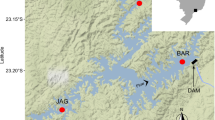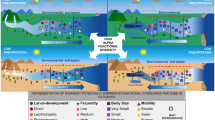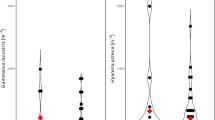Abstract
This study compares the abundance and the spatio-temporal distribution of the shrimps Artemesia longinaris and Pleoticus muelleri, and their relationship with environmental factors (bottom temperature and salinity; sediment texture) at Fortaleza Bay, in Ubatuba, São Paulo State. We performed the samplings from November 1988 until October 1989, and repeated it 20 years later, from November 2008 until October 2009. In both periods, individuals and environmental factors were obtained monthly in seven sampling stations. The relationship between environmental factors and abundance was accessed with a Redundancy Analysis (RDA). In the first period, 3088 specimens of A. longinaris and 151 of P. muelleri were collected, whereas in the second period only 1252 A. longinaris and 72 P. muelleri were found. In both periods, both species were more abundant in stations near the bay’s mouth and in the coldest months. The RDA indicated a positive correlation between species abundance and salinity, and a negative correlation with sediment silt and clay content. The increase in this grain size in the second period may have contributed to the decrease of both species’ abundance. The decrease in salinity during the second period’s winter may also have limited their abundance. This study shows that sedimentation in Fortaleza Bay in these 20 years had positive and negative impacts depending on each species’ habitat. Changes in sediment and salinity could be driving the abundance of these species.









Similar content being viewed by others
References
Almeida AC, Baeza JA, Fransozo V, Castilho AL, Fransozo A (2012) Reproductive biology and recruitment of Xiphopenaeus kroyeri in a marine protected area in the western Atlantic: implications for resource management. Aquat Biol 17(1):57–69. https://doi.org/10.3354/ab00462
Amaral ACZ, Jablonski S (2005) Conservation of marine and coastal biodiversity in Brazil. Conserv Biol 19(3):625–631. https://doi.org/10.1111/j.1523-1739.2005.00692.x
Batista AC, Simões SM, Lopes M, Costa RCD (2011) Ecological distribution of the shrimp Pleoticus muelleri (Bate, 1888) and Artemesia longinaris Bate, 1888 (Decapoda, Penaeoidea) in the southeastern Brazilian littoral. Nauplius 19(2):135–143. https://doi.org/10.1590/S0104-64972011000200005
Castilho AL, Pie MR, Fransozo A, Pinheiro AP, Costa RC (2008) The relationship between environmental variation and species abundance in shrimp community (Crustacea: Decapoda: Penaeoidea) in south-eastern Brazil. J Mar Biol Assoc UK 88(01):119–123. https://doi.org/10.1017/S0025315408000313
Castro RH, Costa RC, Fransozo A, Mantelatto FLM (2005) Population structure of seabob shrimp Xiphopenaeus kroyeri (Heller, 1862) (Crustacea: Penaeoidea) in the littoral of São Paulo, Brazil. Sci Mar 69:105–112
Castro-Filho BM, Brandini F, Pires-Vanin AMS (2003) Costa norte e sul concentram potencial pesqueiro. Scientific American Brasil 12:32–41
Castro-Filho BM, Miranda LB, Miyao SY (1987) Condições hidrográficas na plataforma continental ao largo de Ubatuba: Variações sazonais e em média escala. Boletim do Instituto Oceanografico 35(2):135–151
Conti LA, Araujo CAS, Paolo FS, Barcellos RL, Rodrigues M, Mahiques MM, Furtado VV (2012) An integrated GIS for sedimentological and geomorphological analysis of a lagoon environment. Barra de Cananéia inlet region, (southeastern Brazil). J Coast Conserv 16(1):13–24. https://doi.org/10.1007/s11852-011-0164-1
Costa RC, Fransozo A (2004) Abundance and ecologic distribution of the shrimp Rimapenaeus constrictus (Crustacea: Penaeidae) in the northern coast of São Paulo state, Brazil. J Nat Hist 38:901–912. https://doi.org/10.1080/0022293021000046441
Costa RC, Fransozo A, Castilho AL, Freire FA (2005) Annual, seasonal and spatial variation of abundance of the shrimp Artemesia longinaris (Decapoda: Penaeoidea) in south- eastern Brazil. J Mar Biol Assoc UK 85(01):107–112. https://doi.org/10.1017/S0025315405010908h
Costa RC, Fransozo A, Freire FA, Castilho AL (2007) Abundance and ecological distribution of the “Sete-Barbas” shrimp Xiphopenaeus kroyeri (Heller, 1862) (Decapoda, Penaeoidea) in three bays of the Ubatuba region, southeastern Brazil. Gulf Caribb Res 19(1):33–41. https://doi.org/10.18785/gcr.1901.04
Costa RC, Fransozo A, Mantelatto FLM, Castro RH (2000) Occurrences of shrimps (Natantia: Penaeidea and Caridea) in Ubatuba bay, Ubatuba, São Paulo, Brazil. Proc Biol Soc Wash 113(3):776–781
Costa RC, Fransozo A, Melo GAS, Freire FAM (2003) An illustrated key for Dendrobranchiata shrimps from the northern coast of São Paulo, Brazil. Biota Neotropica 3:1–12. https://doi.org/10.1590/S1676-06032003000100011
Costa RC, Fransozo A, Pinheiro AP (2004) Ecological distribution of the shrimp Pleoticus muelleri (Bate, 1888) (Decapoda: Penaeoidea) in southeastern Brazil. Hydrobiologia 529(1–3):195–203. https://doi.org/10.1007/s10750-004-6410-x
Costa RC, Lopes M, Castilho AL, Fransozo A, Simōes SM (2008) Abundance and distribution of juvenile pink shrimps Farfantepenaeus spp. in a mangrove estuary and adjacent bay on the northern shore of São Paulo state, southeastern Brazil. Invertebr Reprod Dev 52(1–2):51–58. https://doi.org/10.1080/07924259.2008.9652272
D’Incao F (1999) Subordem Dendrobranchiata (camarões marinhos). In: Buckup L, Bond-Buckup G (eds) Os camarões do Rio Grande do Sul. Editora da Universidade, Porto Alegre, pp 271–299
Dall W, Hill BJ, Rothlisberg PC, Staples DJ (1990) Advances in marine biology. In: Blaxter JHS, Southward AJ (eds) The biology of the Penaeidae. Academic Press, London, pp 1–489
De Leo FC, Pires-Vanin AMS (2006) Benthic megafauna communities under the influence of the South Atlantic central water intrusion onto the Brazilian SE shelf: a comparison between an upwelling and a non-upwelling ecosystem. J Mar Syst 60(3–4):268–284. https://doi.org/10.1016/j.jmarsys.2006.02.002
Fransozo A, Costa RC, Castilho AL, Mantelatto FL (2004) Ecological distribution of the shrimp “Camarão Serrinha” Artemesia longinaris (Decapoda, Penaeidea) in Fortaleza Bay, Ubatuba, Brazil, in relation to abiotic factors. Rev Invest Des Pesq 16:45–53
Fransozo A, De Sousa AN, Rodrigues GFB, Telles JN, Fransozo V, Negreiros-Fransozo ML (2016) Crustáceos decápodes capturados na pesca do camarão-sete-barbas no sublitoral não consolidado do litoral norte do Estado de São Paulo, Brasil. Bol Inst Pesca 42(2):369–386. https://doi.org/10.5007/1678-2305.2016v42n2p369
Freire FAM, Luchiari AC, Fransozo V (2011) Environmental substrate selection and daily habitual activity in Xiphopenaeus kroyeri shrimp (Heller, 1862) (Crustacea: Penaeoidea). Indian J Geo Mar Sci 40(3):325–330
Furlan M, Castilho AL, Fernandes-Goes LC, Fransozo V, Bertini G, Costa RC (2013) Effect of environmental factors on the abundance of decapod crustaceans from soft bottoms off southeastern Brazil. An Acad Brasil Ciênc 85(4):1345–1356. https://doi.org/10.1590/0001-3765201394812
Gyllencreutz R, Mahiques MM, Alves DVP, Wainer IKC (2010) Mid- to late-Holocene paleoceanographic changes on the southeastern Brazilian shelf based on grain size records. The Holocene 20(6):863–875. https://doi.org/10.1177/0959683610365936
Hiroki KAN, Fransozo A, Costa RC, Castilho AL, Shimizu RM, Almeida AC, Furlan M (2011) Bathymetric distribution of the shrimp Rimapenaeus constrictus (Stimpson, 1874) (Decapoda, Penaeidae) in two locations off the southeastern Brazilian coast. Mar Biol Res 7:176–185. https://doi.org/10.1080/17451000.2010.489614
Jongman R, Ter Braak CJF, Van Tongeren O (1995) Data analysis in community and landscape ecology. Cambridge University Press, Cambridge
Kaiser MJ, Collie JS, Hall SJ, Jennings S, Poiner IR (2002) Modification of marine habitats by trawling activities: prognosis and solutions. Fish Fish 3:114–136. https://doi.org/10.1046/j.1467-2979.2002.00079.x
Katsanevakis S, Stelzenmüller V, South A, Sørensen TK, Jones PJS (2011) Ecosystem-based marine spatial management: review of concepts, policies, tools, and critical issues. Ocean Coast Manag 54:807–820. https://doi.org/10.1016/j.ocecoaman.2011.09.002
Lepš J, Šmilauer P (2003) Multivariate analysis of ecological data using CANOCO. Cambridge University Press, Cambridge, UK. https://doi.org/10.1017/CBO9780511615146
Magliocca A, Kutner AS (1965) Sedimentos de fundo da Enseada do Flamengo, Ubatuba, SP. Contrib Avulsas Inst Oceanogr 198:1–15
Mahiques MM (1995) Dinâmica sedimentar atual nas enseadas da região de Ubatuba, Estado de São Paulo. Boletim do Instituto Oceanografico 43(2):111–122
Mahiques MM, Bícego MC, Silveira ICA, Sousa SHM, Lourenço RA, Fukumoto MM (2005) Modern sedimentation in the Cabo Frio upwelling system, southeastern Brazilian shelf. An Acad Bras Cienc 77(3):535–548. https://doi.org/10.1590/S0001-37652005000300013
Mahiques MM, Silveira ICA, Sousa SHM, Rodrigues M (2002) Post-LGM sedimentation on the outer shelf-upper slope of the northernmost part of the São Paulo Bight, southeastern Brazil. Mar Geol 181:387–400. https://doi.org/10.1016/S0025-3227(01)00225-0
Mahiques MM, Sousa SHM, Furtado VV, Tessler MG, Toledo FAL (2010) The southern Brazilian shelf: general characteristics, quaternary evolution and sediment distribution. Braz J Oceanogr 58(special issue PGGM):25–34. https://doi.org/10.1590/S1679-87592010000600004
Mahiques MM, Tessler MG, Ciotti AM, Silveira ICA, Sousa SHM (2004) Hydrodynamically driven patterns of recent sedimentation in the shelf and upper slope off Southeast Brazil. Cont Shelf Res 24:1685–1697. https://doi.org/10.1016/j.csr.2004.05.013
Mahiques MM, Tessler MG, Furtado VV (1998) Characterization of energy gradient in enclosed bays of Ubatuba region, south-eastern Brazil. Estuar Coast Shelf Sci 47:431–446. https://doi.org/10.1006/ecss.1998.0368
Mantelatto FL, Bernardo CH, Silva TE, Bernardes VP, Cobo VJ, Fransozo A (2016) Composição e distribuição de crustáceos decápodes associados à pesca do camarão-sete-barbas Xiphopenaeus kroyeri (Heller, 1862) no litoral norte do estado de São Paulo. Bol Inst Pesca 42(2):307–326. https://doi.org/10.20950/1678-2305.2016v42n2p307
Muehe D (2006) Erosion in the Brazilian coastal zone: an overview. J Coast Res 39:43–48
Negreiros-Fransozo ML, Fransozo A, Pinheiro MA, Mantelatto FL, Santos S (1991) Caracterização física e química da Enseada da Fortaleza, Ubatuba, SP. Rev Bras Geoc 21(2):114–120
Odebrecht C, Castello JP (2001) The convergence ecosystem in the Southwest Atlantic. In: Seeliger U, Kjerfve B (eds) Coastal marine ecosystems of Latin America, ecological studies. Springer, Berlin, pp 147–166
Oksanen JF, Blanchet G, Kindt R, Legendre P, Minchin PR, O'hara RB, Simpson GL, Solymos, P, Stevens MHH, Wagner H (2012) Vegan: community ecology package. R package version 2.0–5. http://CRAN.Rproject.org/package=vegan
Pérez-Farfante I, Kensley B (1997) Penaeoid and Segestoid shrimps and prawns of the world. Keys and diagnoses for the families and genera. Mem Mus Natl Hist Nat Paris, pp 1–233
Pires AMS (1992) Structure and dynamics of benthic megafauna on the continental shelf offshore of Ubatuba, southeastern Brazil. Mar Ecol Prog Ser 86:6376
Pires-Vanin AMS, Matsuura Y (1993) Estrutura e função do ecossistema de plataforma continental da região de Ubatuba, Estado de São Paulo: uma introdução. Bol Inst Oceanogr 10:1–8
Team RC (2016) R: a language and environment for statistical computing. R Foundation for Statistical Computing, Vienna
Rakocinski CF, Lyczkowski-Shultz J, Richardson SL (1996) Ichthyoplankton assemblage structure in Mississippi sound as revealed by canonical correspondence analysis. Estuar Coast Shelf Sci 43:237–257. https://doi.org/10.1006/ecss.1996.0067
Sancinetti GS, Azevedo A, Castilho AL, Fransozo A, Costa RC (2014) How marine upwelling influences the distribution of Artemesia longinaris (Decapoda: Penaeoidea). Lat Am J Aquat Res 42(2):322
Schmidt-Nielsen K (2002) Fisiologia animal: adaptação e meio ambiente. Livraria Santos Editora Comércio e Importação Ltda, São Paulo
Simões SM, Costa RC, Fransozo A, Castilho AL (2010) Diel variation in abundance and size of the seabob shrimp Xiphopenaeus kroyeri (Crustacea, Penaeoidea) in the Ubatuba region, southeastern Brazil. An Acad Bras Cienc 82:369–378. https://doi.org/10.1590/S0001-37652010000200013
Wentworth CK (1922) A scale of grade and class terms for clastic sediments. J Geol 30:377–392
Williams AB (1984) Shrimps, lobsters, and crabs of the Atlantic coast of the eastern United States, Maine to Florida. Smithsonian Institution Press, Washington, D.C.
Zar JH (2010) Biostatistical analysis, 5th edn. Prentice-Hall, Upper Saddle River, New Jersey
Acknowledgments
The authors are grateful to the Fundação de Amparo à Pesquisa do Estado de São Paulo (FAPESP), Process n° 2015/12,607/6, to the Conselho Nacional de Desenvolvimento Científico e Tecnológico (CNPq), Process n°401908/88 7ZO and Fundação para o Desenvolvimento da UNESP (Fundunesp), Process n° 287/88/DFP for providing financial support. We are thankful to the NEBECC co-workers fortheir help during the fieldwork.
Author information
Authors and Affiliations
Corresponding author
Ethics declarations
Ethical approval
All sampling in this study was conducted in compliance with current applicable state and federal laws.
Conflict of interest
The authors declare that they have no conflict of interest.
Rights and permissions
About this article
Cite this article
Bernardo, C.H., Sancinetti, G.S., Taddei, F.G. et al. Abundance and spatio-temporal distribution of two Southwest Atlantic endemic shrimps: changes after 20 years. Biologia 73, 589–598 (2018). https://doi.org/10.2478/s11756-018-0066-x
Received:
Accepted:
Published:
Issue Date:
DOI: https://doi.org/10.2478/s11756-018-0066-x




